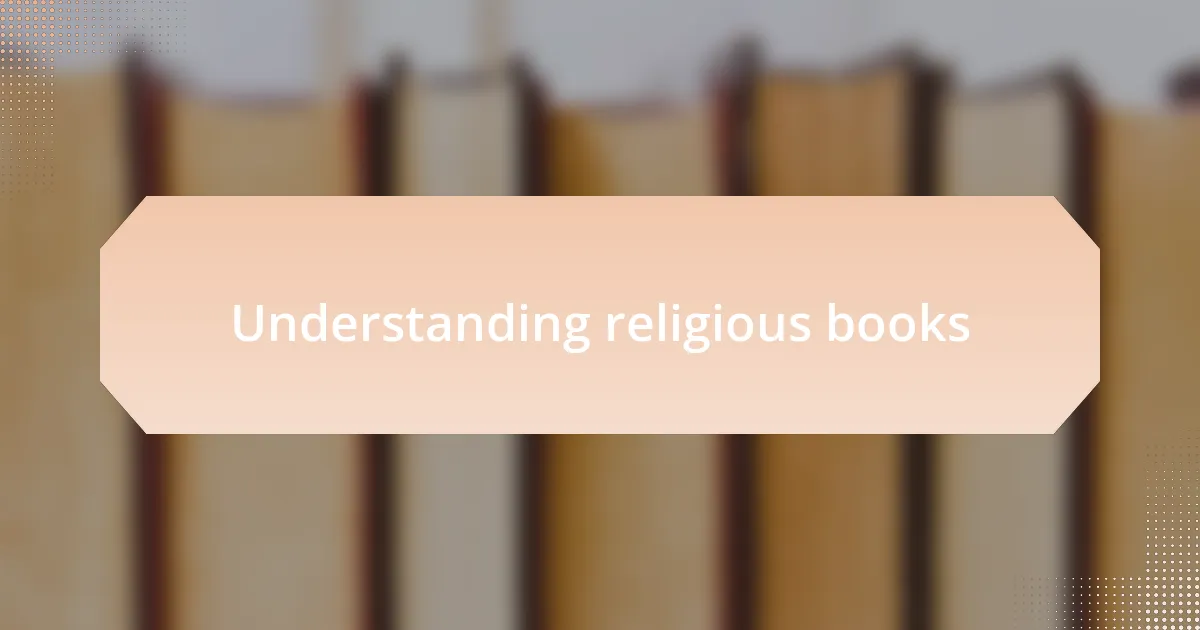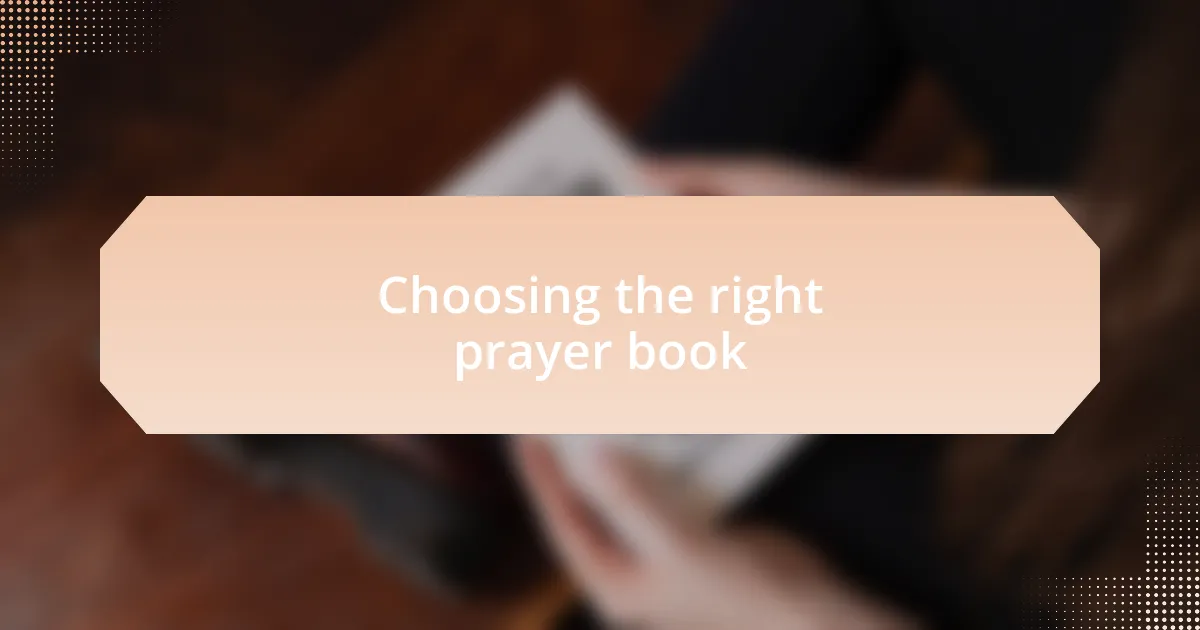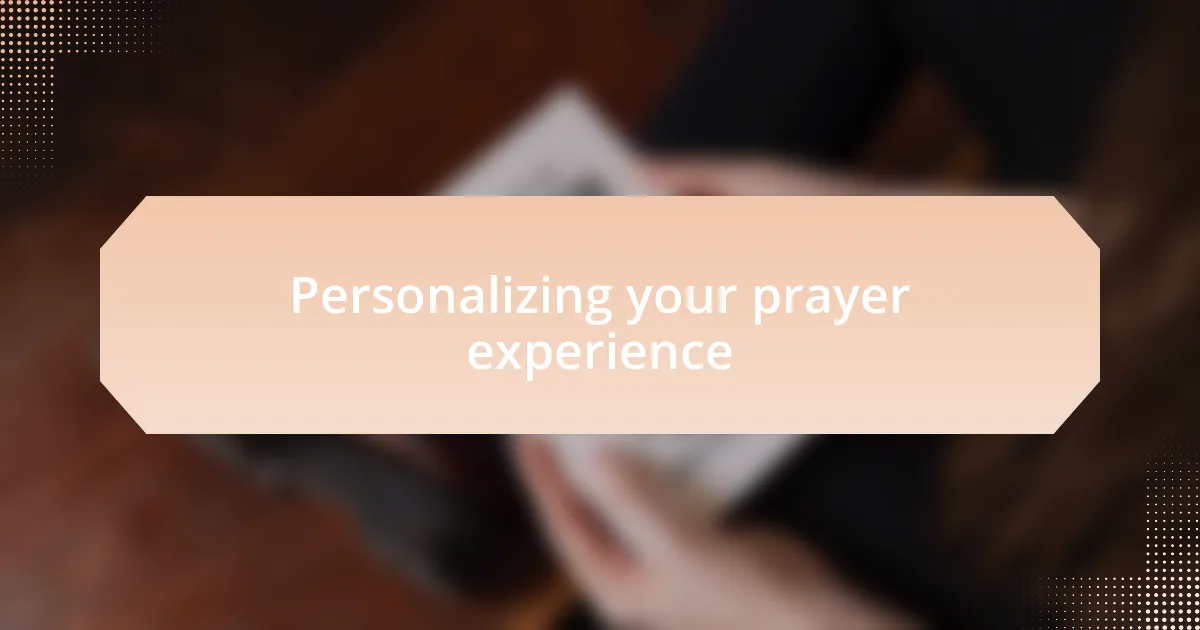Key takeaways:
- Religious books are dynamic tools for spiritual guidance, fostering a sense of community and deepening personal reflection.
- Prayer is essential in worship, serving as a means of connection with the divine and encouraging collective unity among congregants.
- Choosing the right prayer book involves considering personal preferences, language style, and the aesthetic appeal to enhance engagement during worship.
- Personalizing the prayer experience, such as aligning prayers with emotional states and integrating music, significantly enriches spiritual practices.

Understanding religious books
Religious books serve as the foundation of spiritual guidance and moral teachings across various faiths. I remember the first time I cracked open a prayer book during a quiet moment; it felt like embarking on a journey that connected me to something much larger than myself. Isn’t it curious how a simple collection of words can inspire profound reflection and a sense of belonging?
These texts are not just historical artifacts; they are living documents that evolve with their communities. When I attend services, the rhythm of reciting prayers from a book feels like participating in a centuries-old tradition, binding us together in shared faith. Have you ever felt the comfort of those familiar passages during challenging times? It’s astonishing how they can uplift our spirits and provide clarity in moments of confusion.
Understanding religious books also requires recognizing their unique role within different cultures. For instance, in some rituals, the act of reading a prayer book is as important as the prayers themselves. I recall a poignant moment when the congregation united in a chant, each voice weaving a tapestry of hope and faith. Isn’t there something beautiful about how these texts not only articulate beliefs but also create communal experiences that resonate within our hearts?

Importance of prayer in worship
Prayer holds a vital place in worship, acting as a direct line of communication between the faithful and the divine. I remember when I was part of a prayer circle, and each word felt like a weight lifted; it created an atmosphere of surrender and trust. How often do we find solace in pouring out our hearts, knowing that our concerns are heard?
In worship, prayer serves not just as a personal appeal but as a collective expression of unity. During a recent service, I was struck by how the congregation’s voices blended during a communal prayer, transforming individual supplications into a powerful wave of collective hope. Do you feel that pulse of togetherness in those moments? It’s deeply moving to realize that we are not alone in our struggles.
Another important aspect is how prayer can nurture spiritual growth and reflection. I often reflect on the prayers I’ve recited over the years; some were filled with joy, while others dripped with sorrow. Have you considered how different prayers resonate with the various seasons of your life? This evolution not only strengthens my faith but also deepens my understanding of my own journey.

Types of prayer books available
When exploring the types of prayer books available, we can find a rich assortment tailored to different traditions and needs. For instance, I’ve often turned to liturgical prayer books, which are organized around church calendars and ceremonies, helping guide not just my prayers but also the rhythm of my worship. Isn’t it fascinating how these books can transform routine services into profound spiritual experiences through their structured prayers?
Another type to consider is the devotional prayer book, filled with reflections, meditations, and personal prayers that resonate with one’s daily life. I remember picking up a devotional book on a particularly challenging day; the words felt like they were speaking directly to my heart, offering solace and perspective that I desperately needed. Have you ever encountered a passage in a prayer book that seemed to illuminate your circumstances?
Finally, we can’t overlook the beauty of intercessory prayer books, which focus on praying for others. I’ve participated in prayer chains where we’d use such books to guide our petitions, creating a tapestry of hope and compassion shared within our community. It’s remarkable how collectively lifting others in prayer can foster a sense of connection that goes beyond our individual experiences. Each type of prayer book serves a unique purpose, enriching our spiritual journeys in different yet profound ways.

Choosing the right prayer book
When selecting a prayer book, it’s essential to consider your personal spiritual needs and preferences. I once found myself gravitating toward a book that beautifully combined prayers and poetry; it spoke to both my heart and my soul. Have you ever felt a strong connection to the words in a prayer book, as if they were meant just for you?
The language and tone of the prayer book play a crucial role as well. For example, I’ve experienced the difference between contemporary language and traditional liturgy. While I appreciate the beauty of classic texts, sometimes the more modern language feels much more accessible and personal. What resonates more with you—eloquent, time-honored phrases or simple, heartfelt expressions?
Lastly, consider the structure and layout of the prayer book. Some are richly illustrated, which can draw my eye and elevate my worship experience. I remember flipping through a book filled with stunning art, finding that visual beauty deepened my connection to the prayers. Have you noticed how the aesthetics of a prayer book can impact your engagement during worship?

Ways to integrate prayer books
Engaging with prayer books during worship can be a transformative experience. I often find that reading prayers aloud creates an intimate atmosphere that enhances the connection among congregants. Have you ever noticed how sharing prayers in a group can amplify the sense of community, almost like a collective heartbeat resonating in unison?
Another way I integrate prayer books is by personalizing my worship routine. I like to mark specific prayers that resonate with my current life situations, creating a sort of spiritual roadmap. It makes me wonder—how often do we take time to reflect on which prayers we truly need at various stages of our lives?
Additionally, using prayer books for guided reflections can deepen one’s spiritual practice. When I incorporate short pauses or moments of silence after reading a prayer, it allows me to absorb the meaningful words fully. Have you tried pausing to let the prayers settle within you? That practice has often led me to insights that I might have otherwise overlooked amidst the busyness of worship.

Personalizing your prayer experience
Personalizing my prayer experience has always involved more than just the words on the page. I recall a particular time when I felt overwhelmed by life’s challenges; I highlighted a prayer about seeking guidance and wrote personal notes in the margins. This little act made me feel like I was not just reciting words, but having a heartfelt conversation with the Divine, akin to writing a letter to a dear friend.
One practice I find helpful is creating themed sections in my prayer book. For example, during times of joy or celebration, I like to compile prayers that express gratitude and joy. Conversely, during tough times, I focus on prayers that bring comfort and hope. Have you ever considered aligning your prayers with your emotional journey? This alignment can foster a beautiful synergy between your inner state and your spiritual practice.
Finally, I often revisit past entries in my prayer book. Reflecting on how particular prayers helped me navigate previous struggles can be incredibly grounding. It reminds me of the ebb and flow of life and the constant presence of support, nudging me to recognize growth. Isn’t it fascinating how our prayer experiences can evolve as we do?

Tips for effective worship practices
Incorporating regular worship routines can significantly enhance your spiritual experience. I remember setting aside a specific time each week dedicated solely to prayer and reflection. At first, it felt challenging to carve out that hour, but eventually, I found it became a sacred space, transforming my entire week. Do you have a similar ritual that grounds you in your faith?
While using prayer books, consider integrating music that resonates with your soul. I’ve found that playing soft instrumental hymns in the background while reading prayers creates a more immersive experience. It’s almost as if the melodies wrap around the words, allowing me to connect on a deeper emotional level. Have you ever noticed how music can elevate the mood of your worship?
Another tip is to cultivate silence and stillness before diving into your prayer book. In my practice, moments of quiet reflection allow my mind to settle and open my heart. This preparation often leads to more profound insights during my prayer time, as I’m not just reciting words but engaging with them fully. Have you tried this approach? It can truly transform your connection with each prayer.